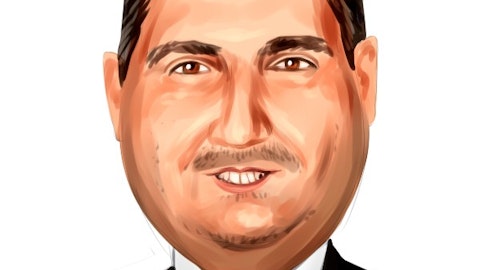Lori Flees: Yeah. The one thing I’d just set context on is our market share of the fleet business is I think less than 1% or around 1%. And our overall market share in the oil change space is about 5%. So we see significant opportunity just to get our fleet penetration or share up to where we are overall as a market. We haven’t shared what our growth rate is on the fleet side, but we expect that it will continue to outpace our overall growth because we are having fantastic discussions with our — with the fleet management companies as well as with small fleet operators. In this past year, we actually expanded some of our fleet work to cover our franchise partners. So when you look at growth in fleet overall, fleet of our company stores is a much stronger growth rate.
But it is — I think on the fleet side we’ll start to see that accelerate. And the less than 10% was on a system-wide basis. So again we see a lot of opportunity on fleet and we’re trying to make sure that we can enable our franchisees to get the benefit of the work we’ve been doing for the company-operated stores.
Mary Meixelsperger: And Lori I’d add that one of the biggest requests we get from our national fleet customers is an expanded footprint. We currently are not in certain locations where they would like us to be. And so continuing to expand that footprint will act as a tailwind to our growth in the fleet business as well.
David Lantz: Great. Thanks.
Operator: Our next question comes from Mike Harrison with Seaport Research Partners. Please go ahead. Your line is open.
Mike Harrison: Hi, good morning. Lori you mentioned earlier that you are undertaking some efforts this year to optimize your marketing efforts and work to improve retention. I was just hoping you could talk in a little bit more detail about what some of those optimization actions are? And also, do you expect to see marketing spend be pretty similar to where it was last year? Or is it moving higher year-on-year?
Lori Flees: I’ll let Mary talk about the marketing spend overall. But in terms of our efforts it’s around — we look at new store marketing. So some of our marketing spend is tied around the number of stores that we’re launching, and where those stores are. Obviously we’ve mentioned before that we’re trying to focus our new store entry in key markets where we’re in filling the market and therefore, marketing costs would be lower than a market that is much less penetrated or new and therefore requires a lot more brand building. But some of the optimization we’re doing both for company and for franchise is around new store marketing and what are the most effective tactics given the penetration in the brand that already exists so that we get a faster ramp on new store sales.
Second is some of the tactics that we’re doing on how to reactivate customers who are inactive. And by inactive, it just means that they haven’t come to us within the last 12 months and we want to find ways to reengage them. And we ran a number of pilots last year on how to do that, doing things like a Father’s Day promotion for inactive customers. Those are days where our volume tends to be lower than what our capacity would be. And so if we can market to inactive customers to come in on days that are not as busy. One, they’re going to get a great experience. The speed is going to be fantastic and it’s a chance to reengage a customer before they defect. The other thing is really optimizing the channels that we go after new customers and doing that in a more surgical way based on our store base.
So we have stores that have been in market for 20 years and the demographics around those stores are not growing at the same pace than other stores. And making sure that we’re spending new customer acquisition dollars in areas that are growing and that we are maybe less mature in the marketplace. So these are taking the dollars that we have both in reminding existing customers that they need to get another oil change given the time that we last saw them, but also optimizing our new customer acquisition, so that our cost of customer acquisition is down on a per customer basis. The last one is we just continue to look at new digital channels and digital tools. We’ve had a robust marketing and CRM backbone relative to our industry. It really is a standout.
But when you compare the things that we have done relative to what broader retail is doing on the digital side, we still see there’s opportunities for us to be more effective and more efficient on the marketing side. But Mary, do you want to comment on marketing spend expectations?
Mary Meixelsperger: Yeah. So overall, marketing as a component of SG&A for the New Year will be growing in line with new store count growth for our company stores. So I expect it to be pretty consistent with a high single-digit SG&A growth that I mentioned earlier. We will see growth in marketing, but it will be pretty much in line with store growth, which is the primary driver of the increases in marketing spend. A lot of what Lori talked about is driving efficiencies in our existing marketing spend. So overall, I’d say that we’re likely seeing a high single-digit increase in marketing for the year — for the New Year.
Mike Harrison: All right. That’s very helpful. And then a couple of housekeeping questions Mary. First of all, can you help us understand a little bit what drove that D&A number to move up somewhat sequentially to that $28 million level. Did you expect that? And can you give us maybe some guidance for D&A expense as well as interest expense next year?
Mary Meixelsperger: Yes. We certainly expected some of it. About 25% of the increase related to just new stores coming online. 75% was related to new technology that was placed in service. Now, a component of that probably about half of it was some catch-up from the prior quarters, where we had placed technology and service earlier in the year and didn’t get the depreciation captured in the quarter. But I would tell you that moving forward, we’ll continue to see increases in depreciation and amortization related to new stores, kind of consistent with where we saw it in the four quarters of this year, but I expect to see modestly higher depreciation and amortization moving forward as we make more technology investments to drive improved experience and more efficiencies in the stores.
So I think the quarter — fourth quarter itself was a bit unusual, because we had some of that catch up. But going forward, you’ll likely see a little bit higher growth rate because some of the new technology investments that we’re making.
Mike Harrison: Great. And interest expense for next year?




